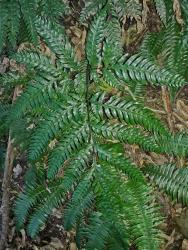Terrestrial, rupestral or rarely (not NZ) aquatic ferns. Rhizome erect to long-creeping, bearing scales or hairs; roots rarely bearing small tubers. Fronds usually monomorphic or rarely dimorphic, not articulated to rhizome. Laminae 1–5-pinnate (NZ) or entire to 6-pinnate (not NZ), sometimes pedate or helicoid (NZ) or palmate (not NZ); herbaceous or coriaceous, glabrous or scaly and/or hairy, rarely farinose abaxially (not NZ). Pinnae or pinna segments sometimes articulated to rachis or costae. Veins free or reticulate, the areolae without included veinlets. Sori extending along the veins, or extending along the margins, or borne on the underside of modified, reflexed, marginal lamina flaps; paraphyses present or absent; sori exindusiate or protected by the unmodified inrolled lamina margin, or by a membranous, reflexed lamina margin; sporangial maturation mixed. Sporangia with vertical or rarely oblique annulus, 16–64 spores per sporangium. Homosporous; spores trilete, lacking chlorophyll; perispores either with coarse ridges and a prominent equatorial flange, or prominently cristate or echinate without an equatorial flange, or plain to tuberculate without an equatorial flange.
A family of five subfamilies, 53 genera and over 1200 species (PPG 1 2016).
Five subfamilies were recognised in this large family by PPG 1 (2016): Parkerioideae, Cryptogammoideae, Pteridoideae, Vittarioideae and Cheilanthoideae. All are monophyletic (Schuettpelz et al. 2007; Zhang et al. 2015), but only the latter three occur in New Zealand, with Anogramma and Pteris in Pteridoideae, Adiantum in Vittarioideae, and Cheilanthes, Myriopteris and Pellaea in Cheilanthoideae.
Allan (1961) included Adiantum, Anogramma, Cheilanthes and Pellaea in Adiantaceae, and placed only Pteris in Pteridaceae, along with Histiopteris, Paesia and Pteridium, which are now included in Dennstaedtiaceae (PPG 1 2016). Myriopteris has only recently been recognised as a separate genus (Grusz & Windham 2013; PPG 1 2016), and the sole New Zealand representative was previously included in Cheilanthes.
| 1 | Sori borne away from the lamina margin, elongated along the veins, unprotected | Anogramma |
| Sori borne on the lamina margin, either unprotected, or protected by the inrolled lamina margin, or by inrolled or reflexed lamina flaps | 2 | |
| 2 | Sori discrete, protected by membranous or unmodified, reflexed or inrolled, lamina flaps | 3 |
| Sori ± continuous along the lamina margin, either unprotected or protected by the membranous or unmodified inrolled lamina margin | 5 | |
| 3 | Sori protected by strongly reflexed, membranous lamina flaps that are orbicular, reniform or shortly rectangular | Adiantum |
| Sori protected by inrolled, green lamina flaps, rarely becoming membranous at their apices | 4 | |
| 4 | Stipes longer than laminae; laminae 3–4-pinnate; abaxial surface bearing long orange hairs; adaxial surface glabrous | Myriopteris |
| Stipes shorter than laminae; laminae 2–3-pinnate; abaxial surface either glabrous, or bearing abundant scales; adaxial surface glabrous or bearing white hairs | Cheilanthes | |
| 5 | Laminae pinnate, <75 mm wide; pinnae articulated to the rachis, often deciduous; sori ± unprotected | Pellaea |
| Laminae more divided, or if pinnate, >75 mm wide; pinnae not articulated to rachis, not deciduous; sori protected by membranous or green inrolled lamina margin | 6 | |
| 6 | Stipes, rachises and pinna costae varying from red-brown distally to yellow-brown proximally; laminae >100 mm wide; veins free or anastomosing; sori protected by membranous, reflexed lamina margin | Pteris |
| Stipes, rachises and pinna costae red-brown throughout; laminae usually <100 mm wide; veins always free; sori protected by green or rarely membranous, inrolled lamina margin | Cheilanthes |
Pteridaceae is a large and diverse family comprising terrestrial or rupestral species with erect to long-creeping rhizomes. Fronds are monomorphic or dimorphic, entire to 5-pinnate, and scaly or sometimes hairy. The sori are either exindusiate and extend along the veins, or are marginal and protected by the modified lamina margin, producing trilete spores.
Pteridaceae is a large family, almost world-wide in distribution, but with its greatest diversity in the tropics and in arid regions (Tryon 1990). Six non-endemic genera with 27 species in New Zealand; five species endemic.
| Category | Number |
|---|---|
| Indigenous (Endemic) | 5 |
| Indigenous (Non-endemic) | 11 |
| Exotic: Fully Naturalised | 5 |
| Exotic: Casual | 7 |
| Total | 28 |




